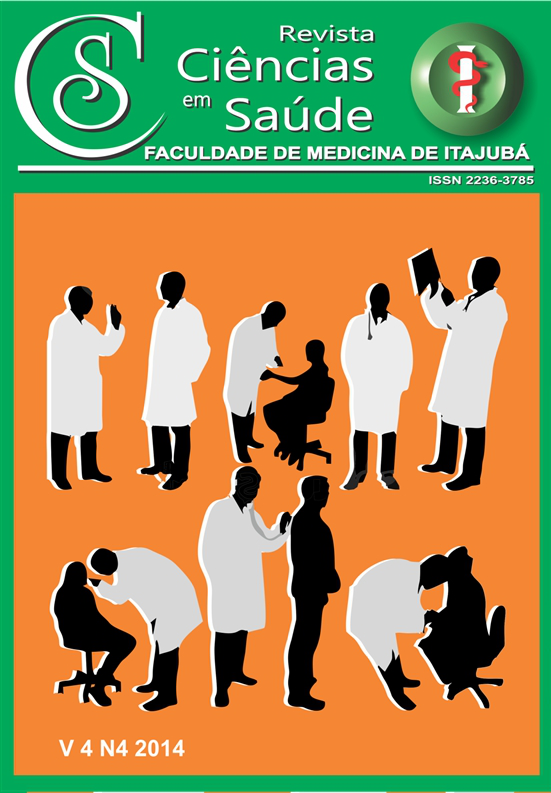Avaliação Cognitiva de Pacientes Idosos Pós Acidente Vascular Encefálico Isquêmico de um Hospital do Sul de Minas Gerais/ Cognitive Assessment of Elderly Patients After Ischemic Cerebrovascular Accident in a Hospital in the South of Minas Gerais
Main Article Content
Abstract
Objetivos: Descrever as variáveis sociodemográficas e clínicas do Acidente Vascular Encefálico (AVCi), correlacionando com déficits cognitivos: orientação, memória, percepção e pensamento abstrato, diagnosticados pelo instrumento de avaliação neuropsicológico, CAMCOG-R. Materiais e Métodos: Para coleta de dados, foi utilizado um questionário de caracterização sociodemográfica e clínica e uma avaliação cognitiva de idosos acometidos por infarto cerebral, decorridos 05 dias, o CAMCOG-R. Resultados: Entre as variáveis estudadas, o fator preditor de sequela no desempenho cognitivo foi à hipertensão, com p=0,032. Apesar do escore global não apresentar diferença estatisticamente significativa, em relação ao tempo de ocorrência do AVCi, verificou-se que na pontuação da subescala orientação espacial, houve uma melhora estatisticamente significativa, com p<0,038. Conclusão: Apenas, a subescala orientação espacial foi significativa na variação de pontuação, enquanto os escores globais se encontravam dentro da normalidade. Evidenciou-se também uma associação do declínio no desempenho cognitivo dos idosos hipertensos, embora sem caracterizar um estado de comprometimento cognitivo definido como demência. Consequentemente, a escala pode ser útil para triagem breve em leito hospitalar e um recurso na exploração do funcionamento cognitivo em pacientes com AVC recente.
Palavras-chave: Idoso, Acidente Vascular Encefálico Isquêmico, CAMCOG-R.
ABSTRACT
Objectives: To describe the sociodemographic and clinical variables of the ischemic stroke, correlated to cognitive deficits: orientation, memory, perception and abstract thinking, diagnosed by a neuropsychological assessment tool, the CAMCOG-R. Materials and Methods: To collect data, a questionnaire of clinical and sociodemographic characterization was used and for cognitive assessment of the elderly with brain stroke, within 05 days, the CAMCOG-R was used. Results: Among the variables studied, the sequel predictor of cognitive performance was hypertension, with p = 0.032. Although the overall score did not show a statistically significant difference in relation to the time of occurrence of the ischemic stroke, it was found out that the subscale scores of spatial orientation had a statistically significant improvement, p <0.038. Conclusion: Only the spatial orientation subscale had a significant variation in scoring, while the overall scores were within normal limits. It also showed a decline in the cognitive performance among elderly hypertensive patients, although not characterizing a cognitive impairment status defined as dementia. Consequently, the scale can be useful for brief screening at a hospital and a resource in the exploration of cognitive functioning in patients with recent stroke.
Keywords: Elderly, Ischemic Stroke, CAMCOG-R.
Article Details
Authors maintain copyright and grant the HSJ the right to first publication. From 2024, the publications wiil be licensed under Attribution 4.0 International 
 , allowing their sharing, recognizing the authorship and initial publication in this journal.
, allowing their sharing, recognizing the authorship and initial publication in this journal.
Authors are authorized to assume additional contracts separately for the non-exclusive distribution of the version of the work published in this journal (e.g., publishing in an institutional repository or as a book chapter), with acknowledgment of authorship and initial publication in this journal.
Authors are encouraged to publish and distribute their work online (e.g., in institutional repositories or on their personal page) at any point after the editorial process.
Also, the AUTHOR is informed and consents that the HSJ can incorporate his article into existing or future scientific databases and indexers, under the conditions defined by the latter at all times, which will involve, at least, the possibility that the holders of these databases can perform the following actions on the article.

